
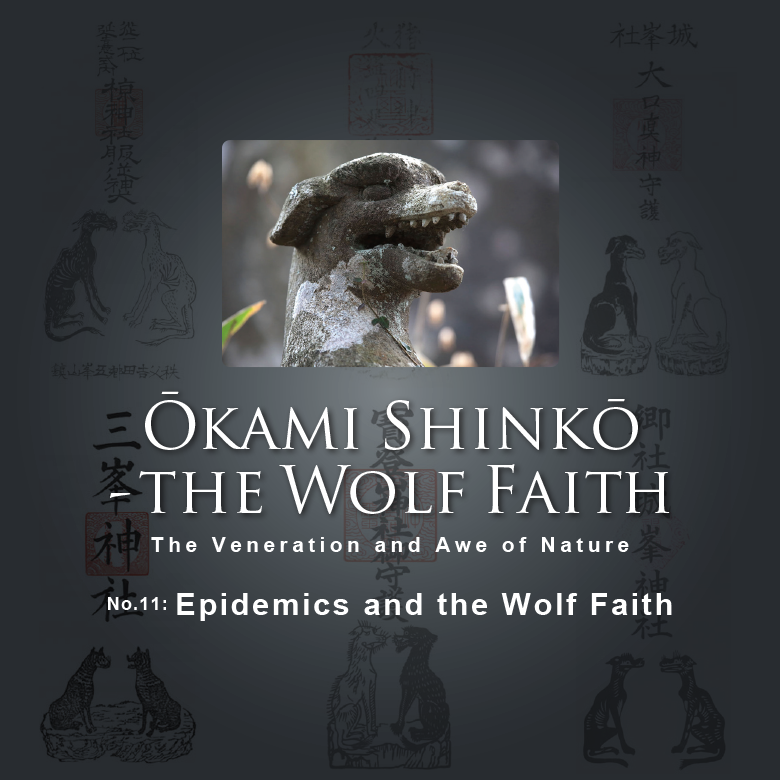
Throughout Japan, there remain regions where wolves are revered as go-kenzoku, or envoys of the gods. In this series of articles, we trace the path of the Ōkami Shinkō, the Wolf Faith. Throughout history, followers of the Wolf Faith have prayed to wolf spirits for intercession in any number of matters. In particular, people have looked to the Wolf Faith to spare them from disease and epidemics.
Text and Photos : 青柳健二 Kenji Aoyagi / English Version : Judy Evans
Keyword : Mitusmine Shrine / Cholera / Coronavirus / Pandemics / Ōkami Shinkō / Japanese Wolf Faith / Covid-19 / SARS
1822 — Cholera Reaches Japan
As of writing (February 15, 2020), COVID-19, the lethal coronavirus outbreak first reported in Wuhan, China in December 2019, has infected tens of thousands of people and is beginning to make its way around the world. While the 2003 outbreak of the related SARS (severe acute respiratory syndrome) virus caused tremendous suffering, what has changed since then is the increased mobility of the world’s population. This ease of international travel appears to be intrinsic to the rapid spread of coronavirus. As frightening as they are though, epidemics are nothing new. This time we look at how Japan’s cholera epidemics of the 1800s led to widespread panic and the growth of the Wolf Faith.

The first of Japan’s several outbreaks of cholera occurred in 1822 in Shimonoseki at the southwest tip of Honshū, having made its way from China and the Korean Peninsula via the island of Tsushima. The disease did not reach the administrative capital of Edo (now Tokyo) during this first outbreak, but the capital was affected decades later during the third epidemic, which lasted three years from 1858 and is thought to have caused the deaths of thirty thousand people. This was the time of the much-resented Ansei Treaties that forced Japan to open its ports to foreign ships after more than two centuries of seclusion. These unequal treaties, combined with the cholera epidemic, sparked a wave of anti-foreigner sentiment.
While it was understood that cholera had come from outside Japan, nobody know how to prevent its spread. In desperation, people turned to traditional faiths, particularly the Wolf Faith, and shrines dedicated to the wolf were inundated with followers seeking to avoid affliction.
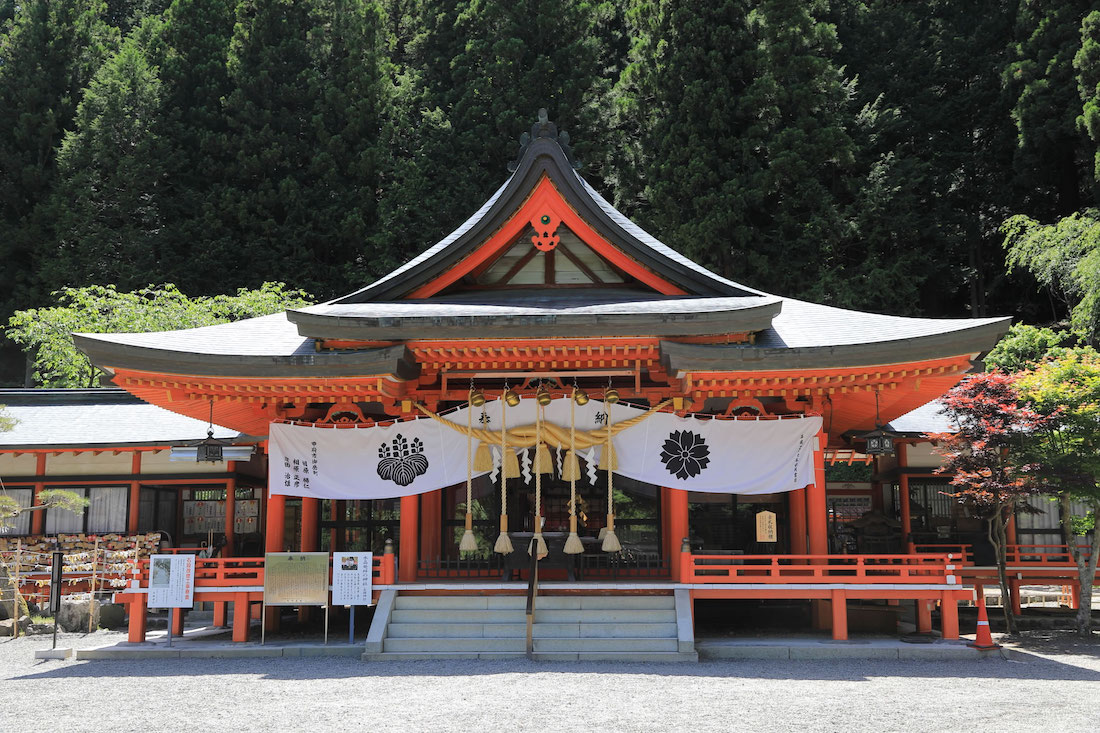
Shrine and temple records from 1868 show that entire villages of the Izu area sought protection from cholera by displaying Oinu-sama ofuda (wolf talismans) issued by Mitsumine Shrine in Chichibu, Saitama Prefecture or by Kanazakura Shrine on Mt Kinpu, Yamanashi Prefecture. Kanazakura Shrine, which still issues wolf talismans today, is dedicated to the kenzoku, or wolf messengers, of the legendary god prince, Yamato Takeru.

In Chichibu, official records of Mitsumine Shrine show a sharp rise in the number of people making their way up the mountain to acquire wolf talismans from the summer of 1858. An entry for August 15th notes a flood of supplicants coming from the city of Edo, as well as from towns along the Tōkaidō route, to pray for deliverance from cholera. More than ten thousand amulets were issued on August 24th, twelve thousand on November 10th, and thirteen thousand on December 15th.
As it was not yet understood how cholera was transmitted nor how to prevent infection, there was nothing for it but to seek divine intervention. It was not until 1883 that the causative agent, the cholera bacterium, was discovered by German doctor and microbiologist, Robert Koch.
People Look to Wolves to Ward off Cholera
When cholera first hit Japan, it was given the name “korori”, a Japanese word that sounded similar to cholera. The original use of the word korori was to describe somebody suddenly collapsing or dropping dead, so it was aptly suited to this mysterious new disease that struck people down so rapidly. Not knowing the cause of the epidemic, people thought it the work of evil spirits. Accordingly, korori was written with the characters for tiger, wolf and tanuki, or sometimes fox, wolf and tanuki – animals associated with the supernatural.
The association of the cholera epidemic with supernatural animals took on an increasingly xenophobic character in the 1850s. Widespread social unrest and anti-foreigner sentiment were already rife amid a series of catastrophic earthquakes and floods and the government policy of excluding foreigners. Bizarre theories abounded that countries seeking to invade Japan had unleashed cholera-spreading monsters such as the “sennen mogura”, a mysterious mole monster, the American fox monster (a trickster like the Japanese fox, but foreign and therefore evil) or the disease-spreading English hare monster (again, just like a Japanese hare, only foreign).
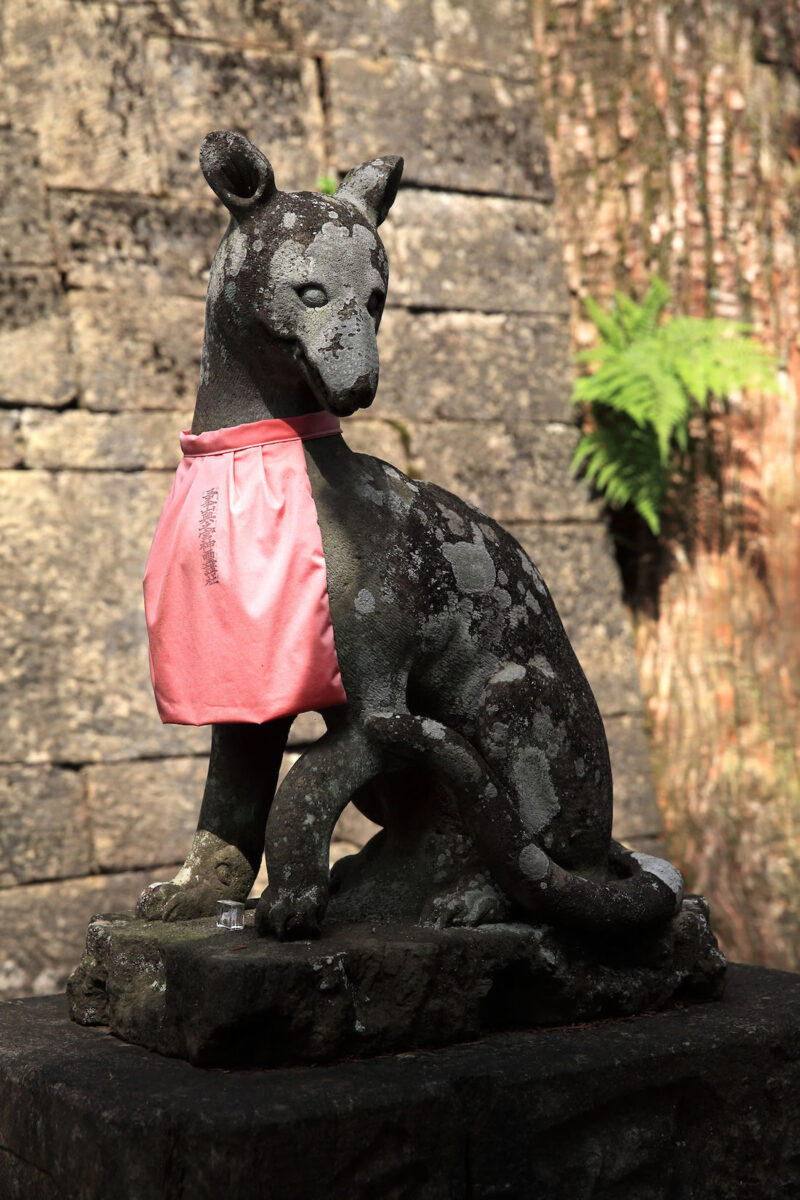
So, why did people look to wolves to ward off cholera?
In his book, “Bakumatsu Kyōran: Korera ga Yatte Kita” (which deals with the arrival of cholera and the frenzy that gripped Japanese society during the chaos of the closing years of the Edo Period) historian Takahashi Satoshi argues that it was only natural for people to turn to the Wolf Faith to combat cholera. After all, who better to fight the disease-spreading “American fox” than the natural enemy of the fox, the wolf!
In a sense, the battle against cholera wasn’t so much a battle of wolf versus fox, but rather, one of Japanese versus foreign. Having been worshipped as a guardian deity since ancient times, the wolf represented all that was good (and Japanese). Supernatural animals such as the American fox monster, on the other hand, stood for the foreign influences that were thought to be responsible for the epidemic. In essence, this was anti-foreign prejudice in a different guise.
Disease and Panic go Hand in Hand
In Okayama, western Honshū, Takahashi City’s Kinoyama Shrine had long been renowned as a place of miraculous cures for contagious diseases and mental illness. During the cholera and typhoid outbreaks of the latter part of the 19th century, a constant stream of people arrived day and night to pray to the wolf deities for deliverance.
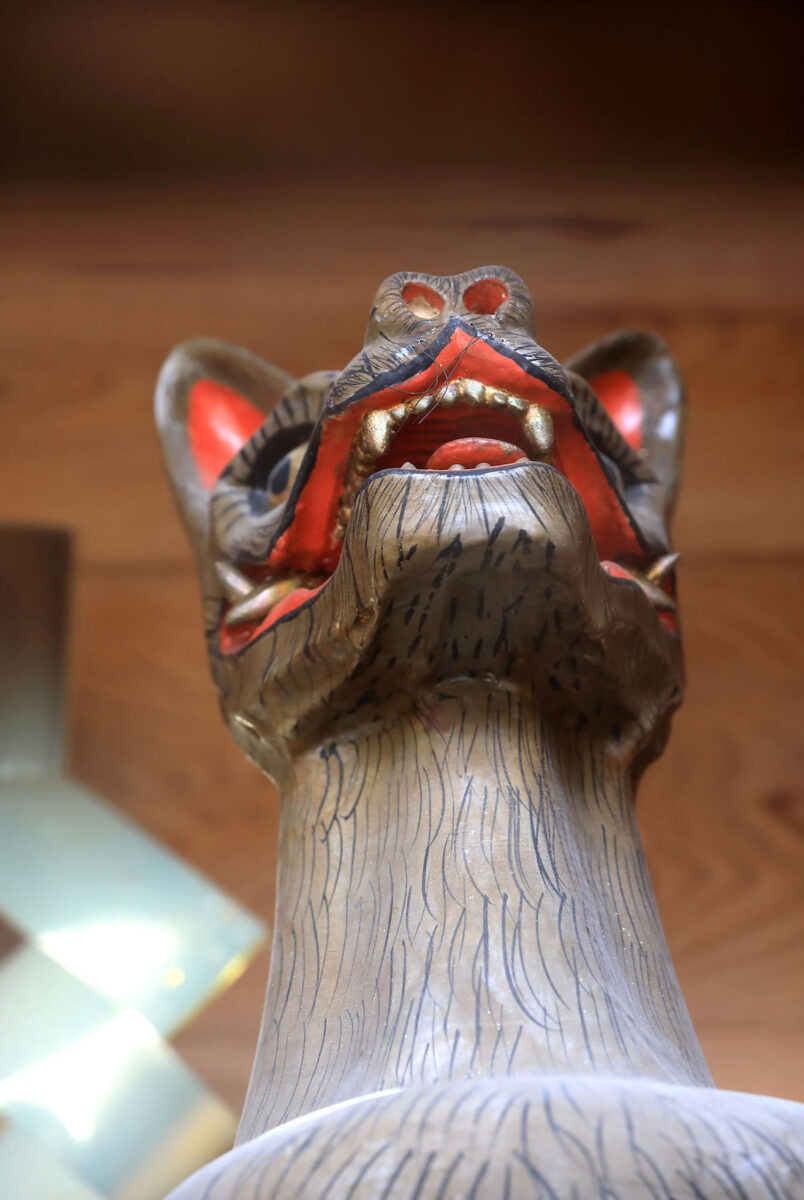
A religious association based on the Wolf Faith was established at Kinoyama Shrine in 1876. Then, with the 1879 cholera outbreak that lasted months, and prompted by the belief that wolves could guard against cholera, Kinoyama Shrine’s Wolf Faith spread out from Okayama Prefecture and became established throughout south-west Honshū and Shikoku.
Also widespread was the belief that remains such as the bones and skulls of deceased wolves could be effective talismans in warding off cholera. The demand for such remains led to wolves being hunted and killed in large numbers. While there were several factors leading to the extinction of the Japanese wolf, this had to be one of them. How sad and ironic then, that the spread of the Wolf Faith contributed to the extinction of the Japanese wolf.
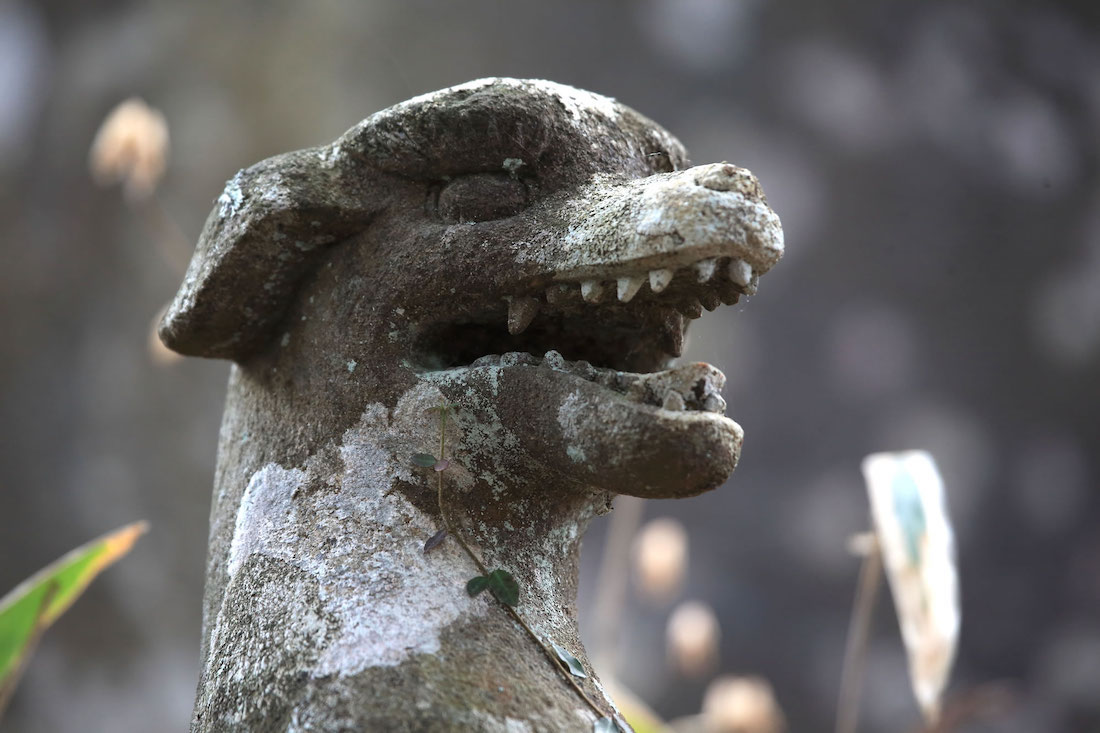
These days we understand that cholera is caused by the cholera bacterium, and SARS or coronavirus by a virus. It seems unlikely that in this day and age the worship of wolves could ever regain the popularity it had during the cholera epidemics of the past. But you never know – humans are notoriously irrational. After all, any number of false rumours and irrational beliefs fostered by ignorance and fear surfaced in the wake of the Fukushima nuclear disaster, so we can’t afford to laugh at the thought that people once believed they could escape cholera by worshipping wolves. Researchers find that, even today, disease and panic go hand in hand.
Reference Materials
「甲州周辺における狼信仰 ━ 笛吹市御坂町に伝わるニホンオオカミ頭骨をめぐって ━」(山梨県立博物館研究紀要 第2集 2008年3月別刷)
Kōshū-shūhen ni Okeru Ōkami Shinkō – Fuefuki-shi Misaka-chō ni Tsutawaru Nihon Ōkami Zukotsu o Mekutte. (2003). Yamanashi Kenritsu Hakubutsukan Kenkyū Kiyō (Yamanashi Prefectural Museum Bulletin), 2 (March Special Edition).
高橋敏『幕末民衆の恐怖と妄想 ━駿河国大宮町のコレラ騒動━』(国立歴史民俗博物館研究報告 第108集 2003年10月)
Takahashi, S. (2003). Bakumatsu Minshū no Kyōfu to Bōsō: Suruga Kuni Ōmiyamachi no Korera Sōdō. Kokuritsu Rekishi Minzoku Hakubutsukan Kenkyū Hōkoku (Bulletin of the National Museum of Japanese History), 108 (October). Kinoyama Jinja. Retrieved from https://www.okayama-jinjacho.or.jp/search/18557/








